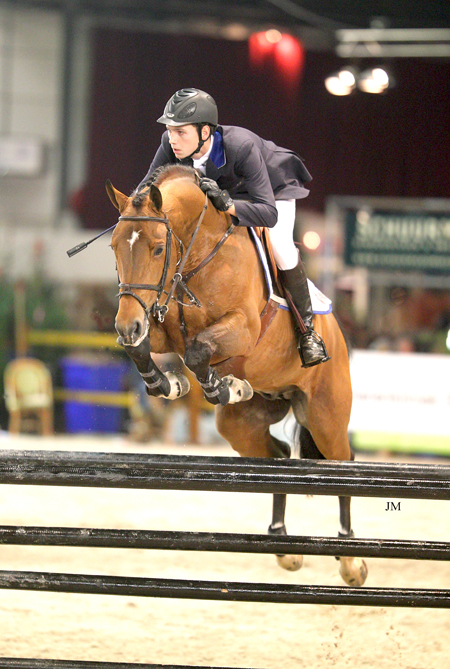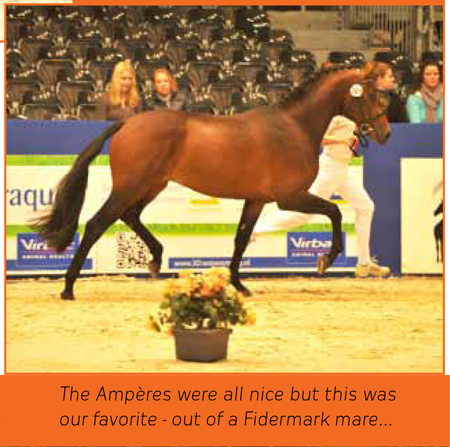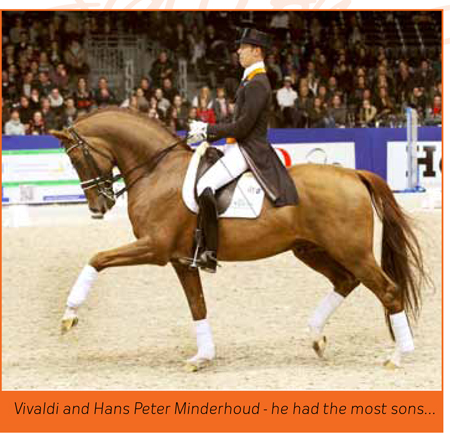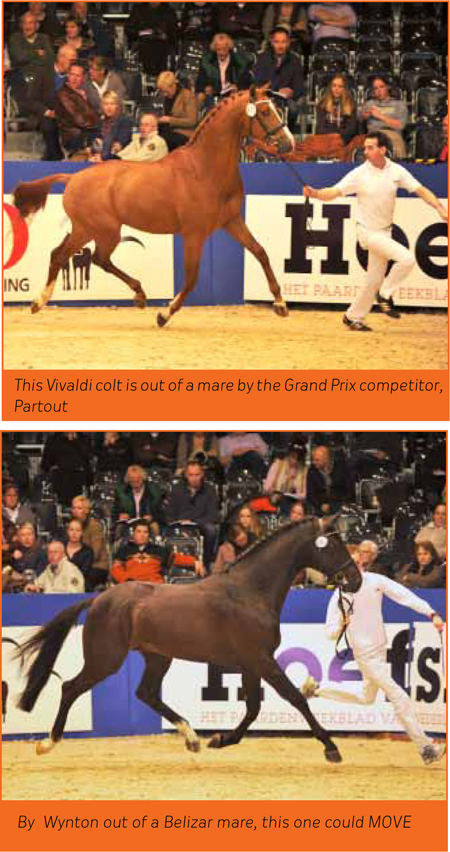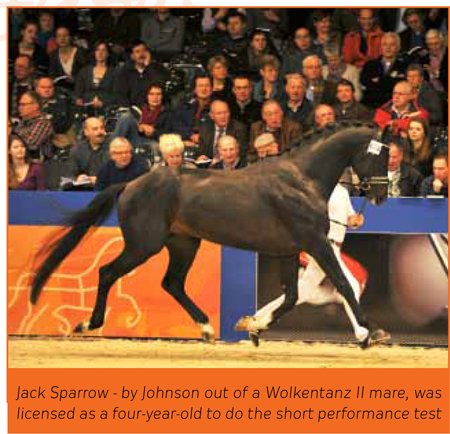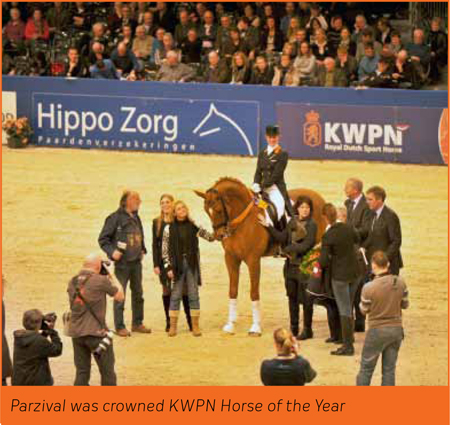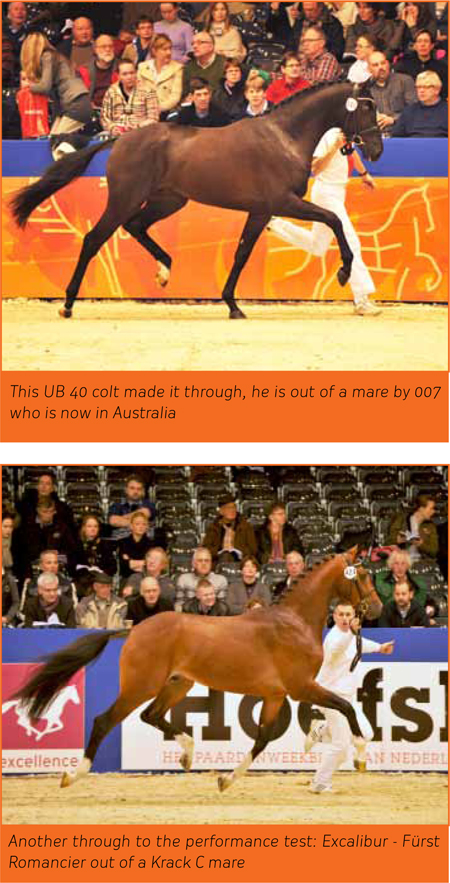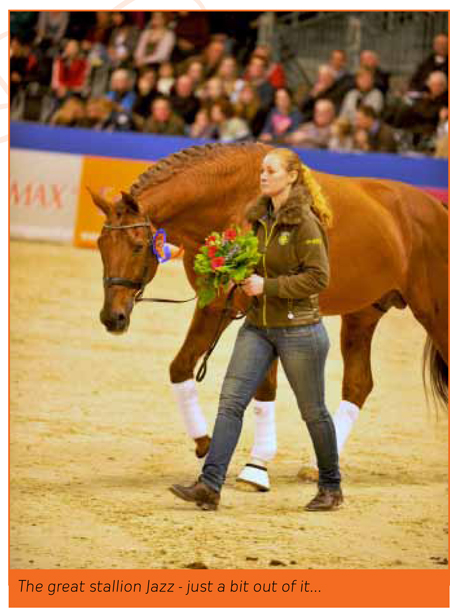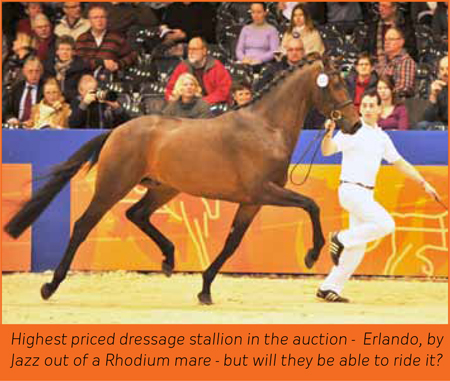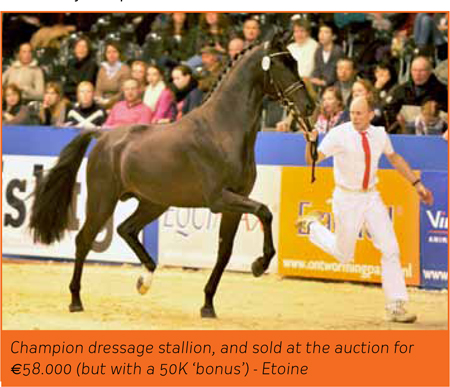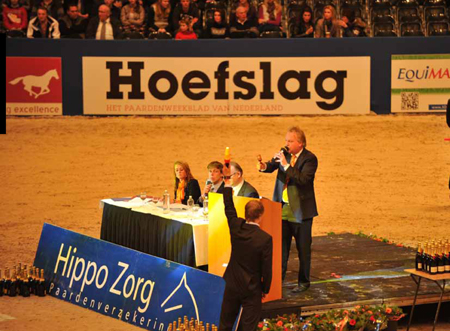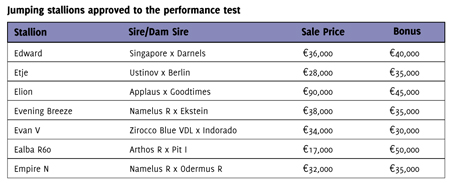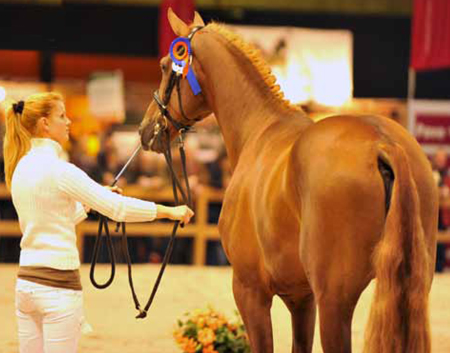Story – Christopher Hector & Photos – Roslyn Neave and Jacob Melissen
It seems that right now Holland is the Performance Horse breeders’ magnet. After this year’s decisive win in the WBFSH standings for both dressage and jumping, it seems even the Germans have jumped on the bandwagon. Last year’s Hanoverian list of new licensed stallions included a swag of Dutch stallions, while in neighbouring Westfalia, the Dutch import, Vitalis is one of their most popular breeding sires. Even in conservative Holstein, they managed to squeeze a Numero Uno colt into the 22 they licensed last year. Looking at the young stallions on show at KWPN Stallion Show in s’Hertogenbosch this year, the success of the Dutch is no surprise, there were superb colts in both the jumping and dressage divisions.
But there was more than the quality of the Dutch horse to drag the world to Den Bosch, the KWPN authorities were to make a major new announcement on their strategy to combat Osteochondrosis (OC) – and luckily for those of us who do not speak Dutch, the new policy was to be outlined at the English Language College that has been held for the past three years as part of the stallion show. Even Gabriele Mohrmann-Pochammer, the editor of the leading German equestrian magazine, St. Georg, made the five hour drive to be on hand for the announcement, while the editor of France’s L’Eperon, Xavier Libbrecht ventured a perilous distance from the vineyards of France to swell the ranks in the press room.
Opening the seminar, KWPN director, J.H. Knaap, made the point that ‘talent is not enough, horses must be healthy.’ From the 1980’s OC had been identified as a problem with three determining factors: * genes * diet * exercise.
The first speaker, Ilse van Gravenhof defined the condition medically, then made the point that damage from OC was estimated to cost 10 million euros a year in Holland alone – which sounds a lot but is probably less than the monthly profit margin in a decent Dutch sales barn, and when you questioned more closely it looked more like a guesstimate than a precise calculation. Ms van Gravenhof made the telling point that the genetic factor was by far the most important since the degree of reduction of OC incidence increased cumulatively with each generation of selective breeding while the environmental strategies – diet and exercise – were only effective for the individual directly involved at the time.
Strategies for reduction were three-fold. The first, excluding stallions from breeding that showed OC health had been practiced in The Netherlands since 1987 for problems in the hock, and since 1994 for problems in the stifle, without eliminating the problem. Identifying gene structures in the DNA that cause OC was a theoretical possibility, but not practical now. The third strategy, offspring testing, offered the most effective and practical solution.
To assess the stallion’s OC health status required testing just 20 yearlings – the information from 200 yearlings was no more reliable than from 20.
The seminar had been sponsored by the feed company, PAVO and the second speaker, Rob Kro, a PAVO employee was given time to spruik the benefits of PAVO’s new magnesium and potassium-based supplement – although the graphs he showed were hardly convincing, and the fix it with feed line has been trotted out by numerous supplement manufacturers over the years with no apparent long term reduction of the OC problem.
KWPN employee, Danïelle Arts is responsible for implementing the new strategy and she explained how future stallions will have an OC breeding value to go along with all the other breeding values, like jumping ability, dressage ability, conformation, etc. However Danïelle did point out that the new breeding value was only applied to stallions approved since 2007 – which cuts out most of the stallions you really wanted to know about. Thumb frantically through their stallion guide to say, Vivaldi, or Ustinov, and you find instead of a value, the initials ‘n.v.t.’ (which means: stallion is according to the selection regulations not part of the structural progeny testing system for osteochondrosis. A breeding value OC-health for this stallion will never be published.) Stallions licensed in 2006 are only nine years old now, so it is going to be many, many years before the top stallions in the KWPN book have a breeding value for genetic health and decades before the majority of foals are sired by stallions with a breeding health value. Although the OC-health breeding value may be great animal husbandry 30 years down the track, right now it is a brilliant marketing and PR move…
The next speaker was another KWPN operative, Hans van Tartwijk. Since mares in the KWPN have been given a PROK (or health) rating since 1989, the idea was to assess the OH health of your mare and then decide if you particularly needed to find a stallion with a very positive OC health breeding value. This raises another interesting question – will the breeders take much notice of the new breeding value for genetic health? Certainly in the past, the breeding values don’t seem to have influenced the mare owners’ choice of stallions. The current fashion for breeding to the latest licensing sensation, means that many of sires with the largest mare books, have no progeny in competition and therefore no breeding values – while at the same time, many of the older established stallions attract large numbers of mares, even though they do not have particularly brilliant breeding values.
It should be noted that the breeding value does not represent any absolute measure of health, just the variation from the mean, which has the value 100. The higher ranked horses might just be the best of a very bad lot, and vice versa, still the results are interesting. In the dressage stallions, Bordeaux (United / Gribaldi) has the highest genetic health index: 113, while Ampère has a value of 103. Four of the more popular young sires are all below average when it comes to OC health: Zizi Top (94), Apache (95), Zhivago (96) and Wynton (99). Arezzo VDL (Chin Chin / Heartbreaker) is the highest ranked of the jumping sires on 106, followed by Calvaro (103) Zirroco Blue (102) and Warrant (101). With a negative ranking we find Vigaro (99), Clinton (98), Zurich (95) and Singapore (92).
Even an OC-sceptic like famed breeder and vet, Jan Greve (it’s not that he doesn’t believe OC exists, just that he thinks other factors are more important) is happy enough with the new breeding value: “It is a good idea for the normal horses – if you have a good horse, then a chip doesn’t matter, you can still always sell them. It is a good start and while we will never eliminate OC completely, this should reduce it greatly.”
Ludwig Christmann from the Hanoverian Verband has been a keen observer at the seminar, how does he think the new Dutch system will work?
“I don’t want to comment too much on the breeding strategy of the KWPN but there is also research being done on the subject in Germany, we are looking more to the genomic part – the genomic selection has already been introduced into cattle breeding and it is on the agenda for horse breeding as well. That is the way we are approaching it, we know that the DNA of the horses can be de-coded and this is the project for the future.”
You don’t think there will be any immediate pressure to follow the Dutch example?
“Nothing is immediately in the pipe-line, we have to complete the research that is underway first…”
One thing puzzles me, ten years ago everyone got very excited about OC but I had the impression that since then, people had learned to deal with it – with nutritional strategies, with exercise regimes, and operating to remove a chip is not such a big deal…
“As we heard at the seminar, there are three parts involved – the feeding and the exercise, and the genetic, and from my point of view, it does make sense to deal with the genetic part. In Hanover there were also some conclusions out of our research project and there are now stricter guidelines for our stallions. As a result we are not accepting stallions with OC in the stifle – we don’t see stallions with OC in the hock or the pastern as such a problem. As Hans van Tartwijk said, there must be the possibility of some compensation, if you have a very good stallion then you must forgive the stallion if he has a little problem there.”
Do you find people – your customers – very worried about OC?
“You have to keep it under control for sure and there are cases where horses lose a lot of value and horses have to be put down because of OC, so it is a problem, you can’t just say you can treat it with surgery and everything is fine, that is not the right approach, we must try to minimize it through breeding but also with the right upbringing and feeding for the foal.”
Okay enough with the theory, let’s get over to where the real action is, the licensing inspections.
The jumping colts are simply amazing, one after another they jump with such fabulous style, and the guys who set up the jumps, and help shepherd them around the ring, are artists.
Really one of the first to look great is Exeter (all 2012 Dutch stallions will have names beginning with the letter ‘e’) and he is an example of the recipe that has worked so well for the Dutch breeders in the past: Holstein stallion over Dutch mare. In this case, the Cassini I son, Berlin, but as breeders all over Europe have found, Berlin needs Thoroughbred on the mare side to work, and Exeter has ‘blood’ aplenty – his dam is by the Lux son, Lupicor (who has lots of Thoroughbred in his background) out of a three quarter Thoroughbred mare.
Increasingly though, the Dutch have stabilized their own breeding cocktail and the stallions with two or more products that have made it to this second round of the licensing, are mostly Dutch: Vigaro (Tangelo van de Zuuthoeve / Renville / Farn), Namelus (Concorde / Joost / Abgar xx), Numero Uno (Libero H / Lord Corlando / Ahorn Z), Zirocco Blue (Mr Blue / Voltaire – and a touch of Selle Français, Le Tot de Semilly)
The ‘outsiders’ are Singapore (like his Eurocommerce stable mate, Berlin, Holsteiner: Acorado / Cantus / Cor de la Bryère), Calvaro (another Holsteiner, Caletto / Capitol / Fantus) and the Belgian bred, Toulon (Heartbreaker / Jokinal de Bornival / Lurano).
Two stallions have four representatives each: Diarado, that Holstein / Selle Français fusion – Diamant de Semilly / Corrado / Contender – and the winner of the 2004 KWPN licensing, Ustinov (Libero / Nimmerdor / Marco Polo).
This is another distinctive feature of the Dutch licensing process, the Commission is very careful to look after the genetic balance of the Dutch horses. New genetics are being introduced all the time to give the breeders the widest choice of bloodlines, and at times you get the feeling that some of the colts that don’t make it through to the third round are victim to the fact that their sires are already well enough represented in the KWPN ranks.
I was lucky enough to again catch up with Paul Hendrix, famed as a breeder and dealer and an executive member of the KWPN. What did he think the second round viewing had told us about the state of jumping horse breeding in Holland?
“I think we had a better group than last year. It was more spread, there were not too many exceptional horses. We were very careful that there was no preparing on the free jumping because we think it is very important that the judges, and also the public, see the real horse and not a prepared horse – we saw one horse that was not natural, and it was sent out.”
“It was a tight group but I think when we have finished the performance tests later in the year, we should have a group of 15 to 20 nice stallions which has the prospect to be jumpers at the higher level with good pedigrees, so they can also be breeding stallions.”
Once again we are seeing the influence of Libero – two years ago, you said to me that Ustinov was going to be the coming stallion, and you must be feeling that your prediction was spot on…
“I’m glad you have such a good memory, I forgot I said it, although it was definitely on my mind – I have to be careful because I am also the part-owner of Ustinov. The influence of Libero is so important for Holland – Numero Uno, Warrant, Ustinov now coming up, we are so blessed with Libero. Actually the nice thing is that this is the arena where Libero took the World Cup title, we should call it the Libero Arena…”
How is Ustinov’s competition career coming along?
“We had a set-back, he had to have an operation, but he is back in work, competing at 1.40m level, and we hope in April/May he can do his first Grand Prix competition again.”
Are you seeing a pattern in his foals?
“If you ask me, what kind of mare Ustinov needs, then I would say a mare with some length because he is a little bit short coupled, and some blood on the dam side is always good because he goes back to Nimmerdor and Marco Polo, very old bloodlines – old but good lines.”
Do you think it is time for Holland to look again to the French blood?
“We are looking, but so far we haven’t found what we would like to find in France. I think we could still use some of the power over the back that the French have in their breeding. We are still looking, and that is the good part of the Dutch breeding, the breeders are so open minded, if there were good horses in South Africa, they would be buying there too.”
And Holstein is still a rich vein to mine – the Berlin horse, was one of the nicest…
“We have very good connections with Holstein, and Holstein will stay important for the rest of our lives. I always say we are blood connected with Holstein. We have a lot of Holstein blood, we have to be picky with what we take, we should not over-do it, but there is a lifeline between Holstein and The Netherlands.”
No doubt, the eventual licensing champion, Elion was the beneficiary of the policy of promoting the new. Of course, he was a super jumper, but you suspect that kick-starting the career of his sire, Applaus, who won the stallion licensing himself just two years ago, had something to do with the choice. Applaus is young enough to have a Genetic health breeding value – in this case a (just) positive ranking of 101.
Elion has a nicely balanced pedigree. Applaus is by the Voltaire son, Unistar out of a grand-daughter of the French great, Grand Veneur. His dam, Nicole, produced the Grand Prix jumper, Stetter (by Manhattan) and she is by the Nimmerdor son, Goodtimes, who is out of a Caletto I mare.
Two other colts made it through to the judging of the Championship: Envoy, by Numero Uno out of a mare by the Thoroughbred, Pharon (again, maintain the genetic diversity of the pool) and Etuloun, by Toulon out of a Calvados / Le Mexico / Lucky Boy xx mare.
I was at the KWPN stallion show in 2010, and two years later, I think the dressage horses are an even better bunch, although the tendency for the quarters to trail out behind still shows up at times.
The Ampères are a lovely line of horses. Ampère himself is solidly Dutch bred, by Rousseau, a son of Ferro, out of a Flemmingh / Amor mare – and it is that large Holstein presence on the stallion’s dam side that seems to benefit from a refining mare. One of the really stand out colts was out of a mare by the Florestan son, Fidermark. Four of the Ampères made it through to the 3rd round. (The initial selections before the stallion show constitute the first round, then at the actual show, there are two rounds and out of the third round, the successful colts are invited to go on to the performance test. The third round also provides the candidates for the Championship Ring.)
There are ten sons of Vivaldi who make it to the second viewing – the largest group by any stallion – with six of them going on to the third inspection. Vivaldi combines the blood that has made the Dutch dressage horse so successful: Krack C, Jazz and Ulft (sire of Ferro).
There are also six sons of Wynton who made it to the stallion show, with four of them going through to the third round. Wynton is a neat Dutch/German cross, being by Jazz, out of a mare by the Danish dressage star, Matador, out of a daughter of Rubinstein.
The final round is going to be exciting… which is more than can be said for the Saturday night program this year. Endless boring presentations and speeches, the final straw is an announcement of an unscheduled 45 minute break and we high-tail it back to our hotel, not even the chance to see British star, Charlotte Dujardin is enough to keep us in our seats. There are cars banked up all over Holland as one the coldest snaps on record rolls over Europe, we certainly don’t want to be stuck in the freezing car park at one in the morning.
It is a bit the same the next day. Okay it was always going to be tough to match up to the fabulous tribute to Gribaldi in 2011, complete with Hans Peter Minderhoud lighting a fire under Painted Black and Edward Gal and Totilas at their sublime best, but the tribute to the great breeder, Huub van Helvoirt, is as flat as yesterday’s pancake. Poor quality stills and very average videos, stretched out of proportion sideways on the big screen, are not a good look, and not very good horses with not very good riders wandering aimlessly around the arena, just don’t make it – and when the great stallion, Jazz entered the arena, he looked as if he had stopped off at one of those famous Amsterdam coffee shops on the way!
They really needed a little help from the cool jazz group (get it?) we found when we got back to our hotel… And why not a pas de deux from Edward and Hans Peter riding the Jazz duo of Sister de Jeu and Apache? It would seem no Dutch show is complete without the dynamic duo in operation. Somewhere this year the show organizers lost their mojo…
Seven colts are approved to go on to do their performance test: Excalibur (Ampère / De Niro / Lord Sinclair), another Excalibur (Fürst Romancier / Krack C / Zichem), Elcapone (UB 40 / OO Seven / Saluut), Emerson (Wynton / Flemmingh / Amor), Escobedo (Vivaldi / Havidoff / Roemer), Expo (Wynton / Belisar / Variant) and the eventual champion, Etoine (Vivaldi / Balzflug / Amor).
The four-year-old Jack Sparrow (Johnson / Wolkentanz / Don Primero) who is being billed as Edward Gal’s new star, is licensed as a four-year-old to go on and do the short performance test, while it is something of an embarrassment for Westfalia when the KWPN knocked back Vitalis at the licensing, damning the stallion with the faintest of faint praise ‘Vitalis is a nice dressage horse, which does not excel enough with his pedigree and strength of the hind leg’ which leaves him licensed in Germany, unlicensed in his native Holland.
Dutch equestrian journalist and breeding expert, Dirk Willem den Rosie is always worth listening to on occasions like this. He is generally happy with the selection:
“We have a broad variety of genes. People here in Holland are afraid that we have too much Krack and Jazz, I have never worried about that, and I think this show has proven that it is not a problem – there is plenty of opportunity to get the best genes and make them available in Holland. For instance, Ampère, we thought we had lost him (the stallion was sold to an American and stands at Jan Brink’s stables in Sweden where he was bred to 141 mares in 2011 making him the most popular stallion in that country) but we haven’t because we’ve seen a couple of his best sons here.”
They really were a type…
“Absolutely. It shows that Holland has the ability to draw the best lines and the best genes to its population. Although we lost our Ampère, now we have a couple of sons to equal him – maybe they are even better than him. I especially liked the combination with Fidermark, that was incredible. He should have been Champion but he was not selected for the Champions ring. The other one that should have been in the Champions ring was the Jazz / Rhodium, but I do not know if he will be trainable because the combination of Jazz and Rhodium is very on the edge, but if the switch goes the right way, he could be a World Champion; a very, very good horse. So although I don’t agree with all the decisions of the Commission, in general I think we have what it takes to cook the cake we need for the Grand Prix – we have all the ingredients here.”
Which group of colts stood out for you?
“Ampère.”
The Vivaldi’s were pretty nice too…
“Yes, but I think we didn’t see the best Vivaldi in the final selection, the Vivaldi – Ferro – Inspekteur, from the dam line of Goliath. We’ve lost him because he was a little bit more awkward, more ugly, we keep looking for more and more refined horses, but for top sport, which is what I am looking for – and I don’t care about the rest – I don’t mind if the horse is a bit more plump or awkward or normal, as long as it does what it takes for the Grand Prix. Vivaldi in my opinion is not the type of horse that will bring Dutch breeding to Grand Prix. Vivaldi is okay if you combine him with a very electric mare – say the best of Ferro – then maybe we can do something with him. Vivaldi is a great sire but we don’t really need him for Grand Prix because his canter is not good enough and his hind legs are slow.”
The Wyntons were disappointing when they walked?
“In general dressage horses don’t disappoint me in walk because I don’t care as much about the walk as I should do. I know it is one of the three basic gaits but it is the basic gait we don’t need so much for Grand Prix. And it is the basic gait that is poorly judged at shows – the first thing that gets lost is the walk. If a two-and-a-half-year-old horse comes into an arena like this, he is supposed to walk badly. I can’t say I don’t care about the walk but it is the thing that I look at the least. I look at a horse to see if it has the ingredients to be a Grand Prix horse, or the sire of Grand Prix horses, and I can do that on the basis of conformation and the way he moves in trot and canter.”
The Fürst Romanciers?
“We saw the best and the worst – one was okay, the other shouldn’t be here – and he was bred by best friends of mine – but a horse that moves his hind legs like that should not be here. Wynton was very good, dressage-type horses, very good hind leg, good interior. Ampère and Wynton were the pick of the sires.”
It is noticeable that the crew on the microphone find their English when they think it is important – like for the auction that rounds out the show. The Dutch have a very curious system at their auction, some of the horses are sold with a ‘bonus’ – in other words, when the horse passes his performance test, the buyer has to pay the seller more money. Thus the champion of the dressage horses, Etoine, who is the first lot, sells for a mere 58,000 euros, with another 50K to pay when he passes his performance test. It would be interesting to see the reaction if you said, ‘just load him on the plane, no one cares about performance tests in Australia’ – then you would have a very cheap horse.
The Jazz / Rhodium that caught Dirk Willem’s eye, rocketed up to sell for 150,000 euros, and the evening was in full swing. In the end the high selling dressage stallion was the Jazz / Rhodium, while the most expensive jumper stallion was the champion, Elion at euro 90,000 and he too comes with a bonus to pay, 45 k after he passes his performance test.
















